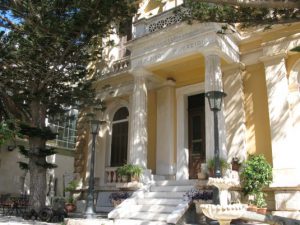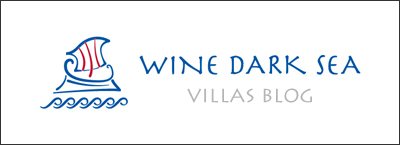None of what happened that day would have occurred if my sister was not an artist.
My family was spending the summer on the island of Crete, and it was one of the few days we weren’t attempting to do something together. Something about the very concept of the Family Vacation necessitates that every second of every day while out and about must be spent with the group as a whole. This is all well and good, for the most part, up until the point where you’ve found it may be better to take a day to be individuals instead of a cohesive family unit, for the sake of the continued family’s cohesion. You could consider it a vacation from the vacation, if you so choose. My sister, the aforementioned artist, wanted to spend her day drawing and painting some of the landscape, a noble endeavor that required art supplies that she, alas, did not have on her. Not to worry, however: a cousin of ours who lived in Heraklion knew exactly where to go. Since this was the day we’d mutually agreed to split up and explore, the rest of our family did not tag along. But I was curious, and figured a walk around the city would do me good. I happen to believe one cannot be bored in a city, and right when one believes there is nothing new left to experience, you stumble across a happy accident.
“It’s just down this street, until you hit the traffic lights. Then turn left. You cannot miss it, it’s, maybe, two blocks? Yes, two blocks away,” our cousin told us, and abruptly drove off, leaving us to our own devices. It seemed simple enough; go forward until you spot the traffic light. How hard could it be?
Well, as it turns out, it was very hard. There wasn’t a traffic light to be seen.

I wanted to take a couple exploratory turns, every so often, but my sister, (a stickler for directions), wanted to keep going in the general direction of ‘straight,’ much to our misfortune. You see, for those who don’t know how the roads that are next to the city center work, they tend to ‘fan’ out, leading perambulators in a diagonal direction away from the center of town. We didn’t find out until we hit the coast, but the part of the coast that has large, Venetian walls showing the line of demarcation between the city and the rest of Crete. A happy accident in its own right, considering I had never seen the walls up close before, (unless you count quickly driving past them). You’d think that this would be the point where we’d want to turn back, and just retrace our steps? Well…
“Well, we’ve hit the coast. The road just loops around to the harbor. We can grab coffee there. Want to just do that?”
“Yeah, okay.”

And so, in silence, we began to follow the road, more or less, with no conception of how far we were walking. We lost the road several times, (please don’t ask us how, because we still aren’t exactly sure ourselves), following the paths that the stray dogs take to navigate the back-ways. It did make for interesting photography, I thought to myself, but I hadn’t expected the hike and so had neglected to bring my camera. It’s just as well. I have a feeling that if I’d lingered in some of those back alleys for too long, the mangy dogs would have been the least of my worries. But we plugged on, thinking north, always north, keep north, (although we were probably going east), when suddenly we’d found the sidewalk once more, and could see the faint outline of the harbor in the distance.
“Oh hey—isn’t this that museum we keep seeing as we drive in?” my sister asked, pointing up to the yellow building that we’d found ourselves in front of.
“It is,” I said. I didn’t bother asking if she wanted to go inside. It was the middle of summer, we’d brought no water with us, and we’d been walking for about an hour. Inside meant air conditioning, water, possibly somewhere to sit. We were going in. Almost immediately, however, we decided to forego the plan to hit the café first, as we quickly became distracted by the wealth of treasures in the museum.

For those who’ve never been to the Historical Museum of Crete, (not to be confused by the more well-known Archaeological Museum closer to the town’s center), you owe it to yourselves to pay it a visit. Museums have always held a special place in my heart, a place that both quiets and excites my mind. This museum was a fabulous treat for me; it began as a general history of the island, which has been host to various cultural influences and conquerors, as some of you probably know. It is a fascinating history, filled with political intrigue and real-life folk heroes. From the Minoan empire, to the conquering Greeks, to the invasion of the Venetians, Ottomans, the reclamation of the Cretan people, this museum takes you on a journey through it all. There is even a section of the museum dedicated to the resistance of the Cretans against the Nazis, and it filled me with joy and pride to see how brave these men and women were in their struggle to liberate their island. (On a personal note, I was especially prideful to find two of my ancestors listed as members of this resistance. My sister and I were able to share a moment that, I expect, is rare to museum goers: seeing personal history and global history collide).

If history isn’t really your favorite subject, you shouldn’t worry. It also plays host to a large amount of art, including some of the most beautiful Byzantine iconography I’ve seen in a single collection. And if post-Byzantine is more your style, you should make a pilgrimage to this place for the sole reason that it is the only play to see the two works by the master El Greco on display on the entire island of Crete: The View of Mt. Sinai and The Monastery of St. Catherine (1570), and the Baptism of Christ (1567). Though he eventually settled in Spain, Domenicos Theotocopoulous (a.k.a. El Greco) was born in Heraklion, and to see him honored in this museum is something truly special. The museum also features a large collection of the works of Nikos Kazantzakis, perhaps one of the best-known Greek writers, (and a Cretan native). For those of you who are bibliophiles, make it a point to visit this part of the exhibit. Books I had never even heard of adorned the walls, correspondence between Kazantzakis and his wife or his friends lie still under a glass pane, and I couldn’t help but admire the covers of the various international editions that all had such beauty to them. It’s a special place for those who love literature and exploring new cultures and voices you may not know to seek out.

We soon received a phone call from our family, who were all now well-rested enough to regroup and take on the rest of the summer as a family unit. They asked us to meet them at Lion Square, not knowing of our small odyssey that had led us through the side ways and byways of the city. We got lucky, though; the museum was only about 500 feet away from the center. Upon spotting us, our family waved us over to them, where they were enjoying a lovely bougatsa at our favorite café.
“Did you find your art supplies?” our father asked.
My sister and I looked at each other before remembering our journey had an initial purpose that, in the excitement, we’d forgotten.
“No,” she told him, and smiled as she reached for a forkful of pastry. “But that’s alright. There’s always the next trip.”
By Katarina Kapetanakis

